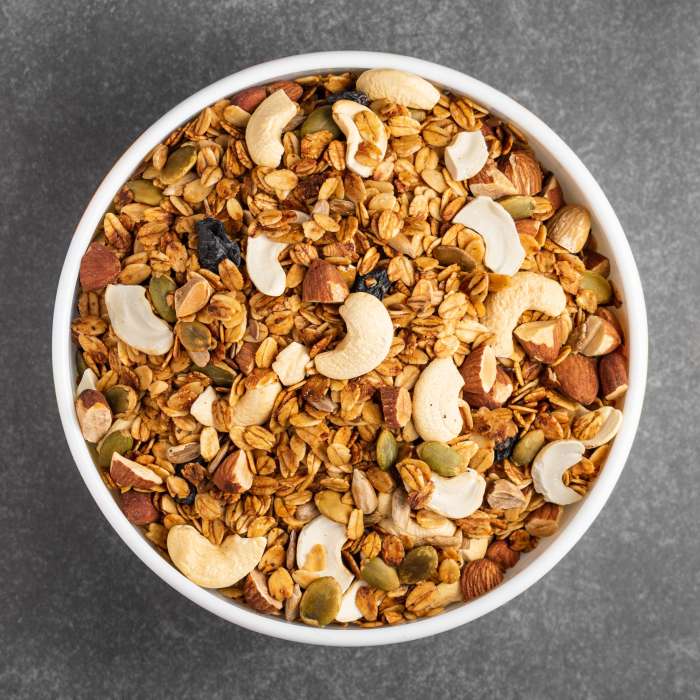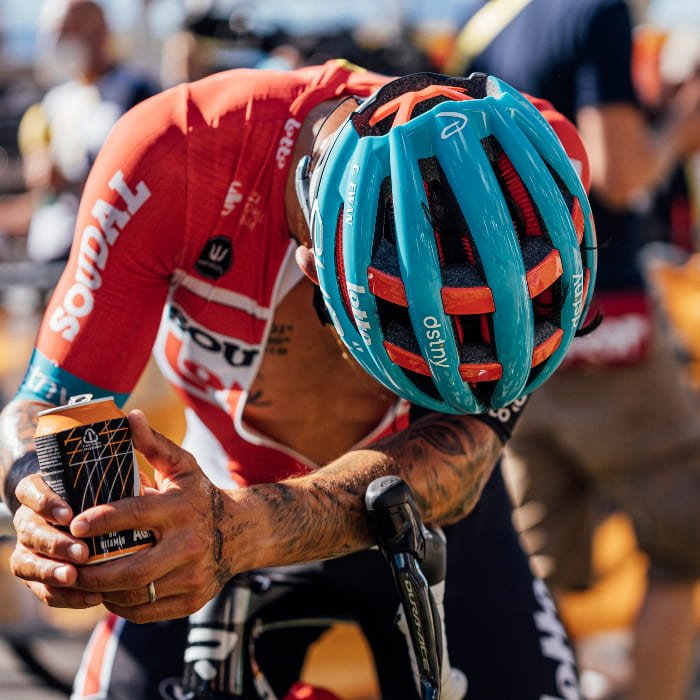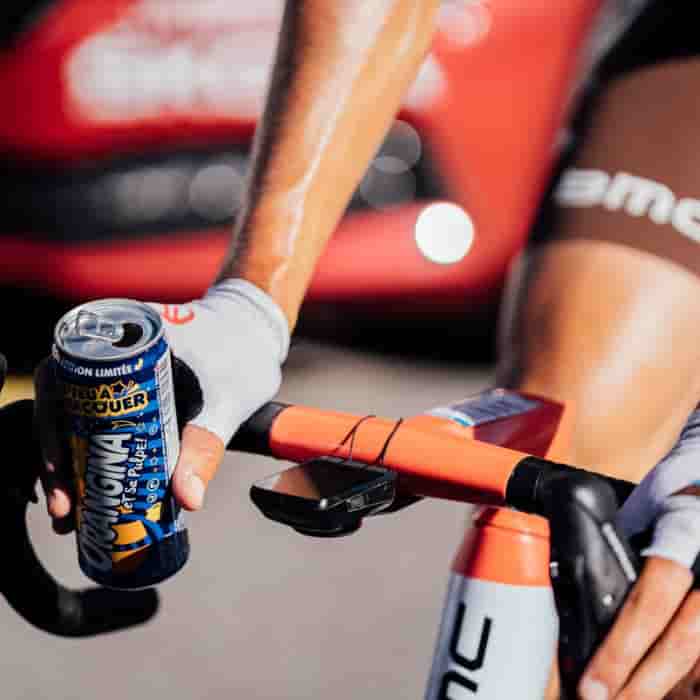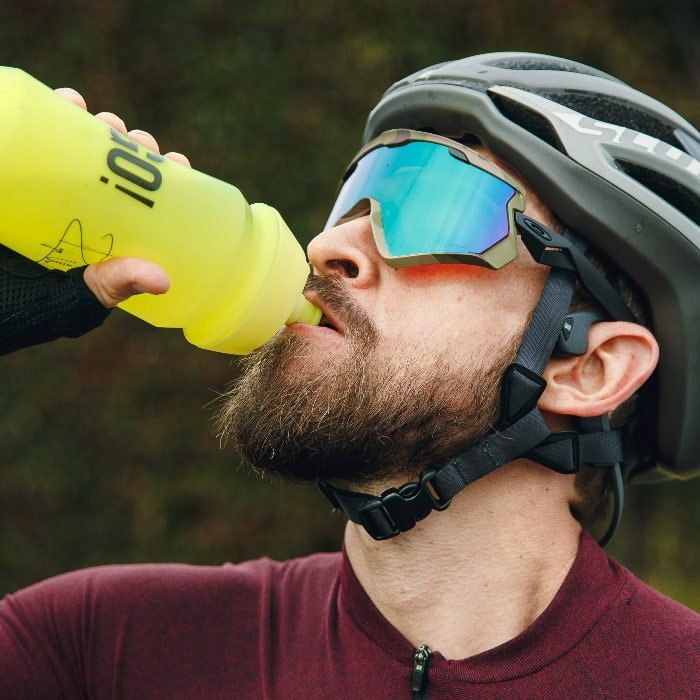There is a lot of guidance out there on how best to fuel endurance-cycling rides; much of it conflicting, and some of it unsubstantiated. To find out what exactly we should be doing, as enthusiastic cyclists, to fuel our rides we spoke with Dr Tim Podlogar, an exercise physiologist at the University of Birmingham. Dr Podlogar has a PhD in Exercise metabolism, and completes research focussed on understanding metabolism before, during, and after exercise. He also works as a performance nutritionist with professional cycling team Bora–Hansgrohe. In short, he’s about as qualified as anyone could be to discuss what to consume when bicycle riding.
- What is the main fuel for cycling?
- Why should you fuel cycling properly?
- How to prepare for a long ride
- What to eat during a ride
- What to eat after a ride
- Breakdown of key points
- Summary table of calories/carbs required
What is the main source of fuel for bike riding?
TP: In short, it’s all about glycogen. But there are three different options for fuelling rides: 1) muscle glycogen 2) blood glucose (which comes from the liver or energy drinks) 3) fats, which will be used no matter what but are slow to use. As endurance athletes, we should be prioritising carbohydrates, and then fats and protein.
Over the years, generally people have been concerned about getting too much fat in their diets, and then suddenly the low-carbohydrate movement kicked in and everyone was concerned about getting too much carbohydrate. Next, everyone wanted protein. Now many athletes I work with are on a high-protein, low-carbohydrate and low-fat diet. From an endurance-cycling perspective, that’s a disaster because they have no energy. Protein is important, but I’d say you only need to have a high-quality source of protein at breakfast and dinner, and also as part of a post-exercise recovery shake.

Photo by ABHISHEK HAJARE
Why is it important to fuel your cycling properly?
TP: Even if you’re not racing in WorldTour stage races, you should still increase your carbohydrates for the typical ‘weekend warrior’ ride. What happens if you don’t eat enough, even if it’s an easy session, is you’ll have cravings after you finish that session. If you are thinking in the long-term you want to lose weight, what’s going to happen is that you will suffer during the session, and then you’ll overeat in the time following your ride and your next session. Whereas, if you keep your calories and carbohydrates high going into your ride, you will be flying on that ride, you’ll come home with plenty of energy left, and you won’t feel the need to park yourself in front of the fridge and eat everything that’s in there. That’s happened to me, it’s happened to everyone. You think it’s low intensity and I don’t need to eat, but that’s what happens.
If you have intervals or hard training rides every single day you really have to minimise the amount of fat you consume, because you want the glycogen, you want to recover. A lot of people that fail these hard training plans aren’t eating enough, and then say the training plan isn’t good. If you follow a training plan that is more polarised, in a week you might have a couple of days of easy spins before your hard rides, but you can actually create a pretty big deficit, meaning you struggle in the hard rides.

Image by SWPix
How do you prepare for a long weekend ride or big event?
Before the Ride
TP: Rule number one from my perspective is, always think ahead. After any training session you do, you need to start think about the next one scheduled. Let’s say you have a long ride planned for Saturday, you need to start thinking about your nutrition on Friday. On Friday, you need to be filling up your carbohydrate and glycogen stores, which means you need to be taking in plenty of carbs throughout the whole day. This is the most important thing and what a lot of people do wrong.
For most people, it gets to Saturday, and they think, ‘I’ve got a big ride, so I need a big breakfast.’ Then they start thinking that on the bike they need lots of carbs, so they have lots of carbs while riding. But then, after the session, they’re super hungry or maybe during the ride they bonk, and it’s because from the start their glycogen stores were not full. You can’t fill up your glycogen stores in a single breakfast, you need a lot of carbs the day before.

Photo by Calum Lewis
How much to eat in the build up to a big bike ride?
TP: It’s hard to say how much to eat exactly, if I say just eat loads and eat well, you’ll probably end up in an energy surplus. The aim isn’t to eat more calories, it’s to play around with the percentages of the make-up of your total calories. So, what I say to my athletes is the amount of carbohydrates needs to really go up to the sky and you need to minimise the amount of fat you consume, so that most the energy you are getting is from carbohydrate.
The actual amounts will depend on what ride or training session you have coming up. For a one-hour long race, like a criterium, you don’t need full glycogen stores. You need plenty, but they don’t need to be full. But if a ride or race is four-hours long, you need really full glycogen stores. This means, typically, consuming eight to 12 grams of carbohydrates per kilo of body weight in the 24-hour build up to a race. That’s in the context of a super-lean, highly fit cyclist. If you are a guy who is a little overweight and isn’t the most powerful cyclist, you can go on the lower side of the recommendations. For the more recreational cyclist, perhaps you could use a realistic ‘ideal’ weight, based on the ideal weight for someone of your height, for example.
Fat intake should be very low, around 0.7–0.8 grams per kilo of body weight. Protein you’ll still need for recovery and building muscle, but if you’re rested and doing only a few sessions in the week and big rides at the weekend, there’s not too much need to worry about protein. I’d keep this in the range of 1.2–1.5 grams per kilo of body weight, that’s sufficient. For the protein, it’s not really hard to reach this. When you’re eating the amount of food needed for these big days, you’ll likely hit this anyway.

Image by SWPix
How much should you consume during the ride
TP: For most people during exercise, I’d aim to take in 40–60 grams of carbohydrates per hour. For most rides of under three hours, the average recreational cyclist could get away with less than 60 grams. If the intensity is really high, you are racing, or for you longer weekend rides, you could increase this to 90 grams. Very rarely would I go above this. During the Tour de France, occasionally I write a recommendation for 100 grams or 120 grams towards the end of a stage.
There’s not much need to go really high for shorter duration rides. There are some people now pushing for really high amounts of carbs per hour, but I don’t see a point personally. It takes time for the body to absorb the carbohydrate going in. When we do studies looking at carbohydrate absorption rates, only at two-and-a-half to three hours do we see big oxidation rates. So, for two hours you don’t even absorb the carbohydrates you ingest. You’ll absorb them during the recovery, so your recovery will be really good, but not during the ride.
It’s like you’re trying to rescue a poor nutrition strategy from the day before. You can use gels and energy drinks to replace some of the glycogen you use on the ride, but you can’t use these as a substitute for having low levels of glycogen in the muscles to begin with. It doesn’t matter if you’re taking in 120 grams of carbs per hour, you can’t make this up on the ride. If you’ve had enough carbs the day before, you shouldn’t be feeling bad during the session or race.
When we go over 60 grams of carbs per hour, we have other considerations to make. We know that the body can only absorb and utilise up to 60 grams of glucose (for example maltodextrin and starch) in an hour. If you want to take in more than 60 grams, you need to add fructose (ordinary table sugar, for example). Incorporating fructose could let you consume 100 or even 120 grams of carbohydrates in an hour. Then you need to be worrying about the ratio. The ratio of glucose to fructose becomes important. Anything from 2:1, 1:0.8, or 1:1 glucose to fructose should work. There’s a mixture of different products available but they all work very similarly.
(For more info on how to make your energy drink check out our blog post.)

Photo by Munbaik Cycling
What to eat eat post-ride?
TP: After your ride, the important thing is you take in some carbohydrate as soon as possible, around 60–80 grams. You want a combination of glucose- and fructose-based carbs, but you don’t need to worry too much about the ratio here. Fructose is important because it goes into the liver, and you want to fill that up pretty quickly, so you don’t feel starving for the rest of the day. You should also take in 20–30 grams of protein. Fat you should keep to a minimum as it will slow the absorption.
The easiest option is something like a protein shake and a piece of fruit. In professional cycling, we’ll usually give the riders a juice and a whey protein shake. Soon after they’ll get a meal of pasta or something like that. For the rest of the day, it depends on what’s next. If it’s Saturday and you’ve got another ride planned for Sunday, you want to keep topping up your carbohydrate stores. If it’s Sunday and Monday’s a rest day, you could have a bit more protein and wholegrains, which will help fill you up.

Photo by Tom Austin
Summary of Key Points
- Focus on increasing carbohydrate intake and limiting fats
- The day prior to a big ride, training session, or race aim for 8–12 grams of carbohydrate, 0.7–0.8 grams of fat, and 1.2–1.5 grams of protein per kilo of body weight
- During the ride, consume between 40–60 grams of glucose-based carbohydrates per hour for rides under two hours. Above two hours you can increase this to up to 90 grams, in a 2:1 ratio of glucose to fructose.
- Most gels are around 20 or 40 grams of carbohydrates, so it’s simple, either one or three gels per hour.
- After your ride take in carbohydrates and as quickly as possible. Around 60–80 grams of carbohydrates and 20–30 grams of protein
- Fuel for you next ride, training session, or race.
Breakdown of Consumption Requirements
| Consumption requirements based on carbohydrate intake at 8g per kg of body weight; protein 1.2g per kg; fat 08.g per kg | |||||||
| Rider Weight (kg) | Carbs | Calories | Protein | Calories | Fat | Calories | Total Calories |
| 60 | 480 | 1920 | 72 | 288 | 48 | 432 | 2640 |
| 70 | 560 | 2240 | 84 | 336 | 56 | 504 | 3080 |
| 80 | 640 | 2560 | 96 | 384 | 64 | 576 | 3520 |
| 90 | 720 | 2880 | 108 | 432 | 72 | 648 | 3960 |
| Consumption requirements based on carbohydrate intake at 10g per kg of body weight; protein 1.2g per kg; fat 08.g per kg | |||||||
| Rider Weight (kg) | Carbs | Calories | Protein | Calories | Fat | Calories | Total Calories |
| 60 | 600 | 2400 | 72 | 288 | 48 | 432 | 3120 |
| 70 | 700 | 2800 | 84 | 336 | 56 | 504 | 3640 |
| 80 | 800 | 3200 | 96 | 384 | 64 | 576 | 4160 |
| 90 | 900 | 3600 | 108 | 432 | 72 | 648 | 4680 |
| Consumption requirements based on carbohydrate in take at 12g per kg of body weight; protein 1.2g per kg; fat 08.g per kg | |||||||
| Rider Weight (kg) | Carbs | Calories | Protein | Calories | Fat | Calories | Total Calories |
| 60 | 720 | 2880 | 72 | 288 | 48 | 432 | 3600 |
| 70 | 840 | 3360 | 84 | 336 | 56 | 504 | 4200 |
| 80 | 960 | 3840 | 96 | 384 | 64 | 576 | 4800 |
| 90 | 1080 | 4320 | 108 | 432 | 72 | 648 | 5400 |
For nutrition and performance products we have a wide range to keep you moving.
